Fundamental Properties and Self-Healing Performance of Repair Mortar with Solid Capsules Made Using Inorganic Reactive Powder
Abstract
:1. Introduction
2. Materials and Test Methods
2.1. Solid Capsules
2.2. Repair Mortar
2.3. Test Methods for Fundamental Properties of Repair Mortar
2.3.1. Rheological Properties
2.3.2. Mechanical Properties
2.4. Test Methods for Healing Performance of Repair Mortar
2.4.1. Water Permeability Test
2.4.2. Crack Monitoring and Analysis of Healing Product
3. Results and Discussion
3.1. Fundamental Properties of Repair Mortar
3.1.1. Rheological Properties
3.1.2. Mechanical Properties
3.2. Healing Performance of Repair Mortar
3.2.1. Water Flow Rate
3.2.2. Healing Index
3.2.3. Crack Monitoring
4. Conclusions
- In terms of the rheological properties of the repair mortars containing SC, the plastic viscosity and yield stress decreased with the addition of SC, and the flow tended to decrease as well. The strength of the repair mortar tended to decrease with the addition of SC. The effect of SC on the air content was not significant.
- Through the water permeability test on repair mortars containing SC, it was found that the healing performance increased rapidly during the initial seven days of the healing period and increased more gradually thereafter. The healing performance of repair mortars containing SC increased as the amount of SC increased, indicating that the addition of SC could significantly increase the healing performance.
- When cracks were induced after 91 days of age, the healing performance of repair mortars was improved by adding SC. Accordingly, it was confirmed that SC can preserve healing performance even after a long time because they are coated with a membrane material to delay the hydration of core materials.
- Consequently, it is necessary to determine the optimal SC amount for self-healing repair mortar by considering not only the healing parameters, such as the target crack width, healing period, and healing index, but also the quality of the repair mortar, including rheological and mechanical properties. Through these results, the optimal mixing ratio of SC considering the fundamental properties and healing performance of the repair mortar might be 5% by mass of binder.
Author Contributions
Funding
Institutional Review Board Statement
Informed Consent Statement
Data Availability Statement
Conflicts of Interest
References
- De Belie, N.; Gruyaert, E.; Al-Tabbaa, A.; Antonaci, P.; Baera, C.; Bajare, D.; Darquennes, A.; Davies, R.; Ferrara, L.; Jefferson, T.; et al. A review of self-healing concrete for damage management of structures. Adv. Mater. Interf. 2018, 5, 1800074. [Google Scholar] [CrossRef]
- De Rooij, M.R.; Schlangen, E. Self-Healing Phenomena in Cement-Based Materials; State-of-the-Art Report of RILEM Technical Committee 221-SHC; Springer: Cham, Switzerland, 2011. [Google Scholar]
- Ferrara, L.; Van Mullem, T.; Alonso, M.C.; Antonaci, P.; Borg, R.P.; Cuenca, E.; Jefferson, A.; Ng, P.L.; Peled, A.; Roig-Flores, M.; et al. Experimental characterization of the self-healing capacity of cement-based materials and its effects on the material performance: A state of the art report by COST Action SARCOS WG2. Constr. Build. Mater. 2018, 167, 115–142. [Google Scholar] [CrossRef] [Green Version]
- Mihashi, H.; Nishiwaki, T. Development of engineered self-healing and self-repairing concrete-state-of-the-art report. J. Adv. Concr. Tech. 2012, 10, 170–184. [Google Scholar] [CrossRef] [Green Version]
- Murakami, T.; Ahn, T.H.; Hashimoto, T.; Ogura, N.; Kishi, T. A study on the new water repair method for subway tunnels using crack self-healing repair materials. In Proceedings of the Fifth International Conference on Self-Healing Materials, Durham, NC, USA, 22–24 June 2015. [Google Scholar]
- Ahn, T.H.; Kishi, T. Crack self-healing behavior of cementitious composites incorporating various mineral admixtures. J. Adv. Concr. Tech. 2010, 8, 171–186. [Google Scholar] [CrossRef] [Green Version]
- Van Tittelboom, K.; De Belie, N.; De Muynck, W.; Verstraete, W. Use of bacteria to repair cracks in concrete. Cem. Concr. Res. 2010, 40, 157–166. [Google Scholar] [CrossRef]
- Jonkers, H.M.; Thijssen, A.; Muyzer, G.; Copuroglu, O.; Schlangen, E. Application of bacteria as a self-healing agent for the development of sustainable concrete. Ecol. Eng. 2010, 36, 230–235. [Google Scholar] [CrossRef]
- Lee, H.; Wong, H.; Buenfeld, N. Self-sealing of cracks in concrete using superabsorbent polymers. Cem. Concr. Res. 2016, 79, 194–208. [Google Scholar] [CrossRef] [Green Version]
- Alghamri, R.; Kanellopoulos, A.; Al-Tabbaa, A. Impregnation and encapsulation of lightweight aggregates for self-healing concrete. Constr. Build. Mater. 2016, 124, 910–921. [Google Scholar] [CrossRef]
- Nesterova, T.; Kim, D.; Pedersen, L.T.; Kiil, S. Microcapsule-based self-healing anticorrosive coatings: Capsule size, coating formulation, and exposure testing. J. Organ. Coat. 2012, 75, 309–318. [Google Scholar] [CrossRef]
- Huang, H.; Ye, G.; Damidot, D. Characterization and quantification of self-healing behaviors of microcracks due to further hydration in cement paste. Cem. Concr. Res. 2013, 52, 71–81. [Google Scholar] [CrossRef]
- Van Tittelboom, K.; Gruyaert, E.; Rahier, H.; De Belie, N. Influence of mix composition on the extent of autogenous crack healing by continued hydration or calcium carbonate formation. Constr. Build. Mater. 2012, 37, 349–359. [Google Scholar] [CrossRef]
- Van Tittelboom, K.; De Belie, N. Autogenous healing of cracks in cementitious materials with varying mix compositions. In Proceedings of the 2nd International Conference on Self-Healing Materials, Chicago, IL, USA, 28 June–1 July 2009. [Google Scholar]
- Choi, Y.W.; Oh, S.R.; Choi, B.K. A study on the manufacturing properties of crack self-healing capsules using cement powder for addition to cement composites. J. Adv. Mater. Sci. Eng. 2017, 2017, 1–8. [Google Scholar] [CrossRef] [Green Version]
- Oh, S.R.; Choi, Y.W.; Kim, Y.J. Effect of cement powder based self-healing solid capsule on the quality of mortar. Const. Build. Mater. 2019, 214, 574–580. [Google Scholar] [CrossRef]
- Qureshi, T.S.; Kanellopoulos, A.; Al-Tabbaa, A. Encapsulation of expansive powder minerals within a concentric glass capsule system for self-healing concrete. Constr. Build. Mater. 2016, 121, 629–643. [Google Scholar] [CrossRef]
- Mostavi, E.; Asadi, S.; Hassan, M.M.; Alansari, M. Evaluation of self-healing mechanisms in concrete with double-walled sodium silicate microcapsules. J. Mater. Civ. Eng. 2015, 27, 04015035. [Google Scholar] [CrossRef]
- Li, V.C.; Herbert, E. Robust self-healing concrete for sustainable infrastructure. J. Adv. Concr. Technol. 2012, 10, 207–218. [Google Scholar] [CrossRef] [Green Version]
- Kishi, T.; Koide, T.; Ahn, T.H. Effect of granules on the workability and the recovery of water tightness of crack self-healing concrete. J. Cer. Proc. Res. 2015, 16, 63–73. [Google Scholar]
- Alghamri, R.; Kanellopoulos, A.; Litina, C.; Al-Tabbaa, A. Preparation and polymeric encapsulation of powder mineral pellets for self-healing cement based materials. J. Const. Build. Mater. 2018, 186, 247–262. [Google Scholar] [CrossRef] [Green Version]
- Feng, J.; Dong, H.; Wang, R.; Su, Y. A novel capsule by poly (ethylene glycol) granulation for self-healing concrete. Cem. Concr. Res. 2020, 133, 106053. [Google Scholar] [CrossRef]
- Kim, Y.J.; Choi, Y.W. Utilization of waste concrete powder as a substitution material for cement. Const. Build. Mater. 2012, 30, 500–504. [Google Scholar] [CrossRef]
- Park, S.; Lee, E.; Ko, J.; Yoo, J.; Kim, Y. Rheological properties of concrete using dune sand. Const. Build. Mater. 2018, 172, 685–695. [Google Scholar] [CrossRef]
- ASTM C 1437; Standard Test Method for Flow of Hydraulic Cement Mortar. ASTM: West Conshohocken, PA, USA, 2020.
- ASTM C 185; Standard Test Method for Air Content of Hydraulic Cement Mortar. ASTM: West Conshohocken, PA, USA, 2020.
- ASTM C 109; Standard Test Method for Compressive Strength of Hydraulic Cement Mortars. ASTM: West Conshohocken, PA, USA, 2020.
- ASTM C 1583; Standard Test Method for Tensile Strength of Concrete Surfaces and the Bond Strength. ASTM: West Conshohocken, PA, USA, 2013.
- ASTM C 348; Standard Test Method for Flexural Strength of Hydraulic-Cement Mortars. ASTM: West Conshohocken, PA, USA, 2021.
- ASTM C 157; Standard Test Method for Length Change of Hardened Hydraulic-Cement Mortar and Concrete. ASTM: West Conshohocken, PA, USA, 2017.
- Lee, K.M.; Kim, H.S.; Lee, D.K.; Shin, K.J. Self-healing performance evaluation of concrete incorporating inorganic materials based on a water permeability test. Materials 2021, 14, 3202. [Google Scholar] [CrossRef] [PubMed]
- Gruyaert, E.; Debbaut, B.; Snoeck, D.; Díaz, P.; Arizo, A.; Tziviloglou, E.; Schlangen, E.; De Belie, N. Self-healing mortar with pH-sensitive superabsorbent polymers: Testing of the sealing efficiency by water flow tests. Smart Mater. Struct. 2016, 25, 084007. [Google Scholar] [CrossRef]
- Roig-Flores, M.; Moscato, S.; Serna, P.; Ferrara, L. Self-healing capability of concrete with crystalline admixtures in different environments. Constr. Build. Mater. 2015, 86, 1–11. [Google Scholar] [CrossRef]
- Feiteira, J.; Gruyaert, E.; De Belie, N. Self-Healing of Moving Cracks in Concrete by Means of Encapsulated Polymer Precursors. J. Constr. Build. Mater. 2016, 102, 671–678. [Google Scholar] [CrossRef]
- An, E.J.; Kim, H.J.; Gwon, S.W.; Oh, S.R.; Kim, C.G.; Sim, S.H.; Shin, M.S. Monitoring of self-healing in concrete with micro-capsules using a combination of air-coupled surface wave and computer-vision techniques. J. Struct. Health Monit. 2021, 1–17. [Google Scholar] [CrossRef]
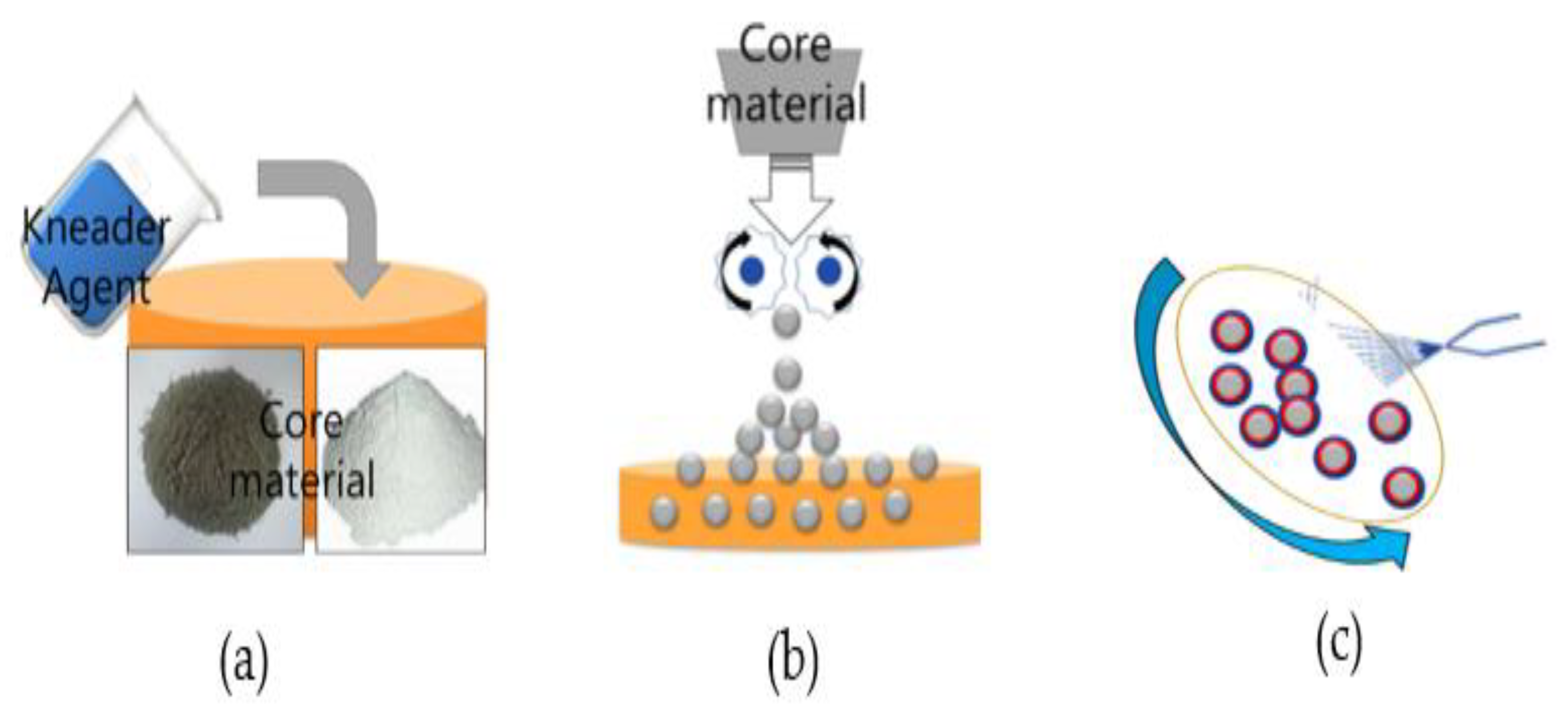
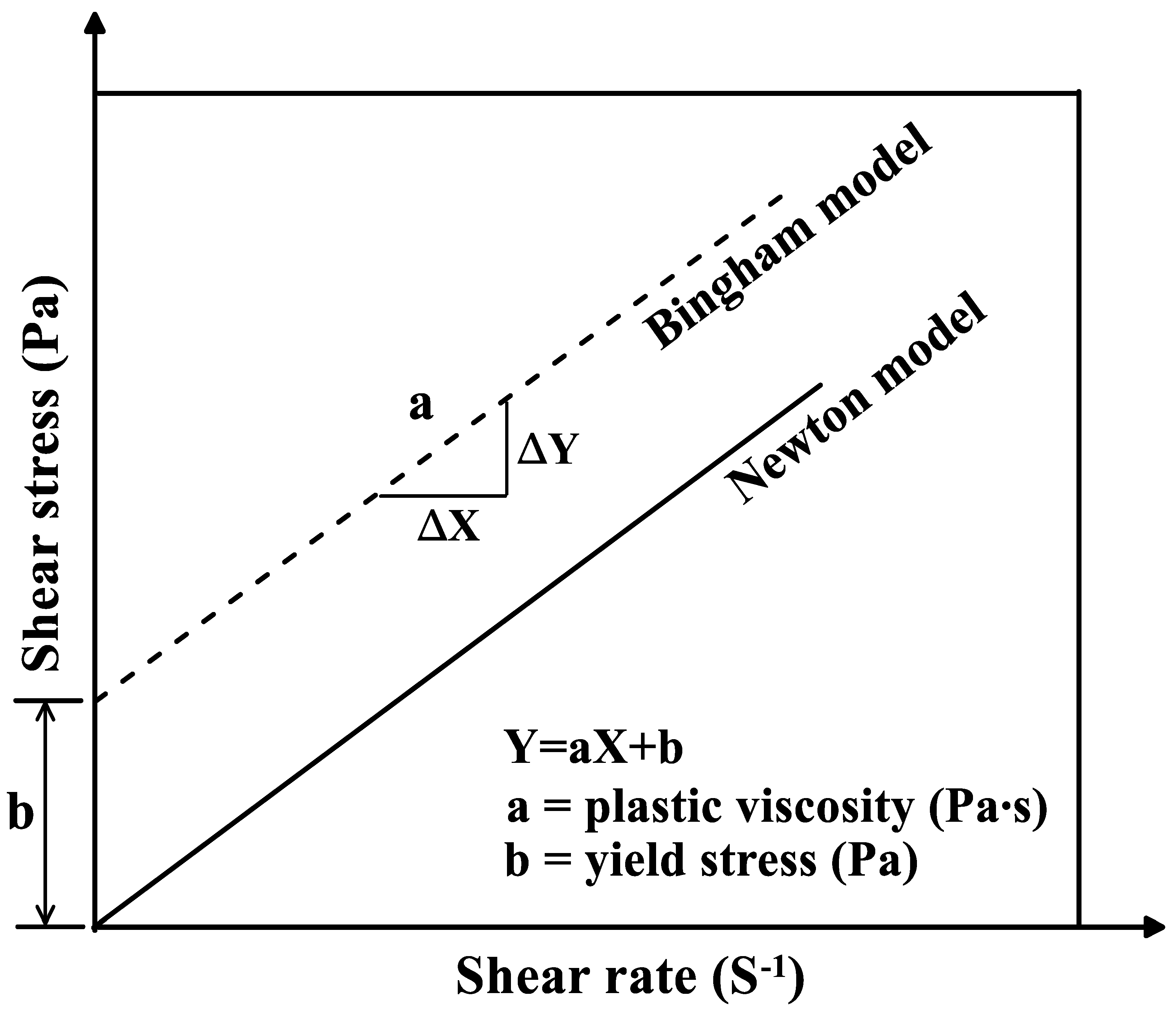
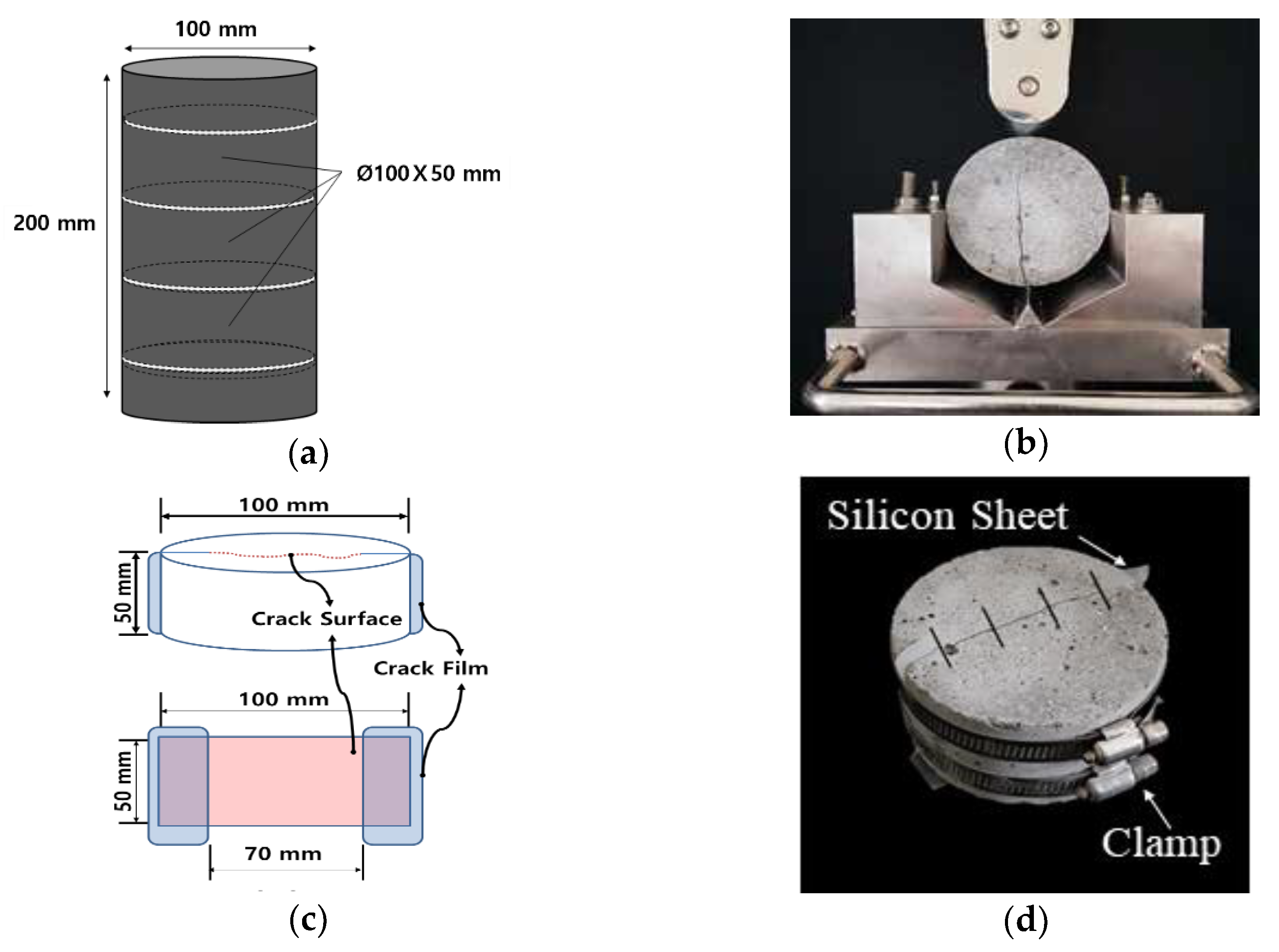
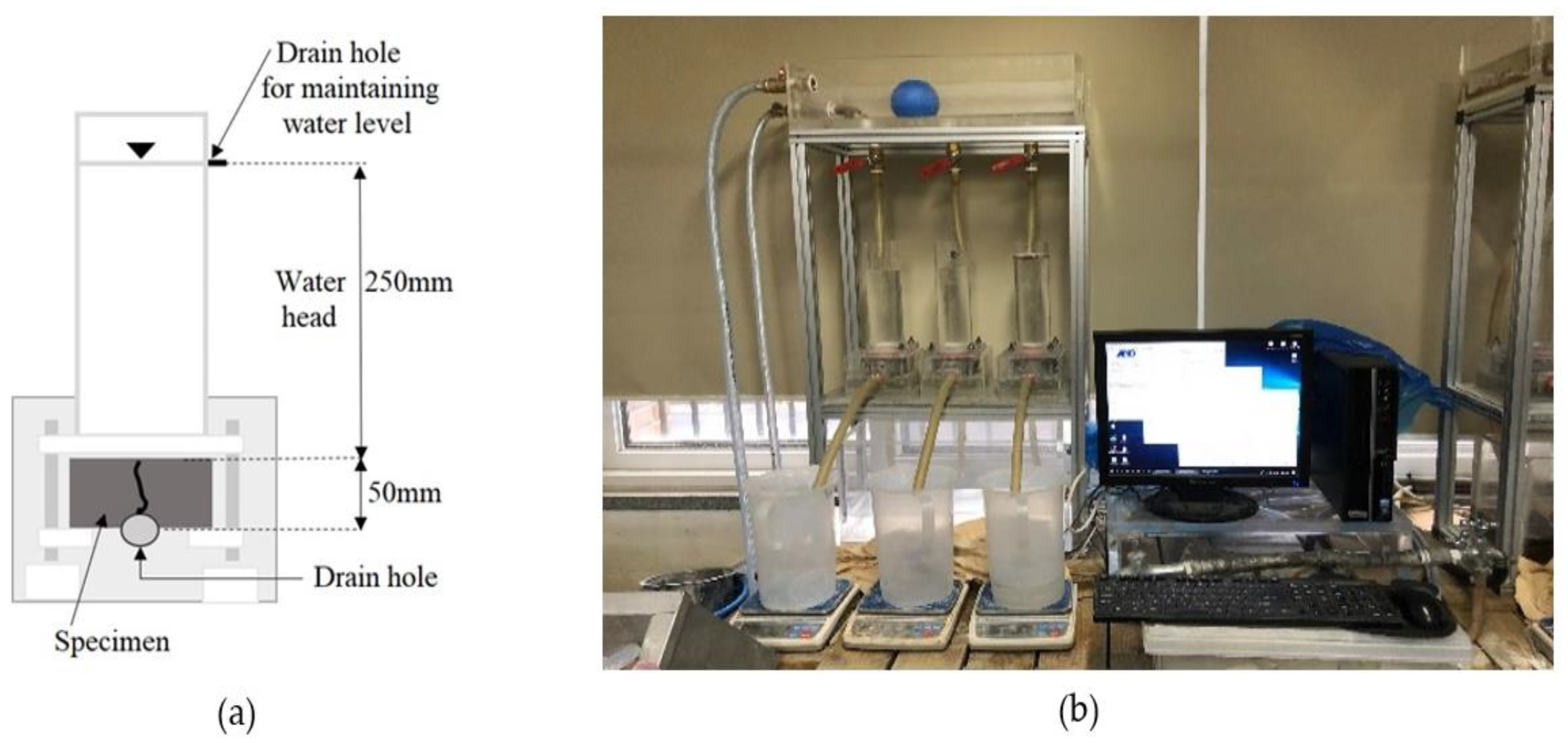

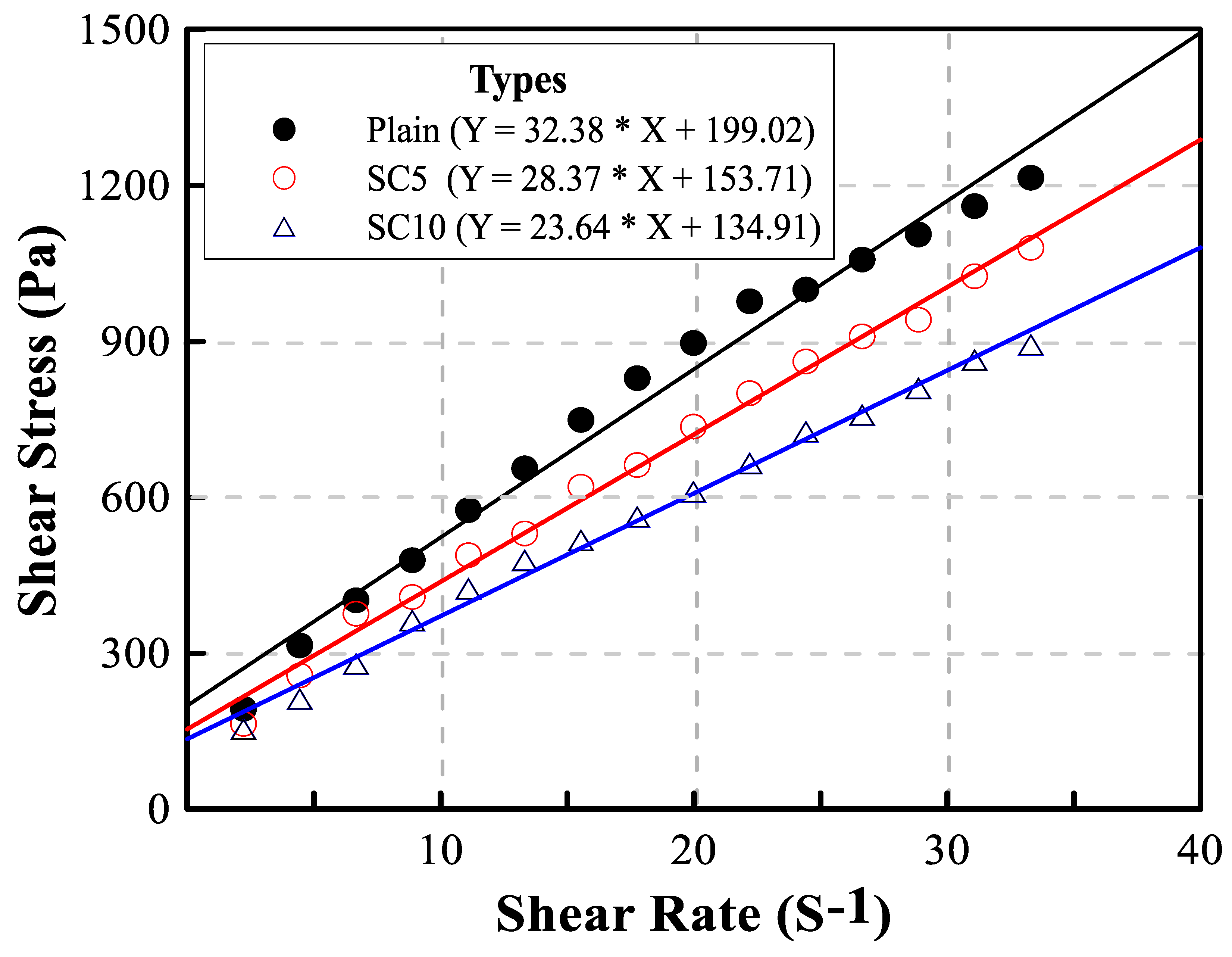
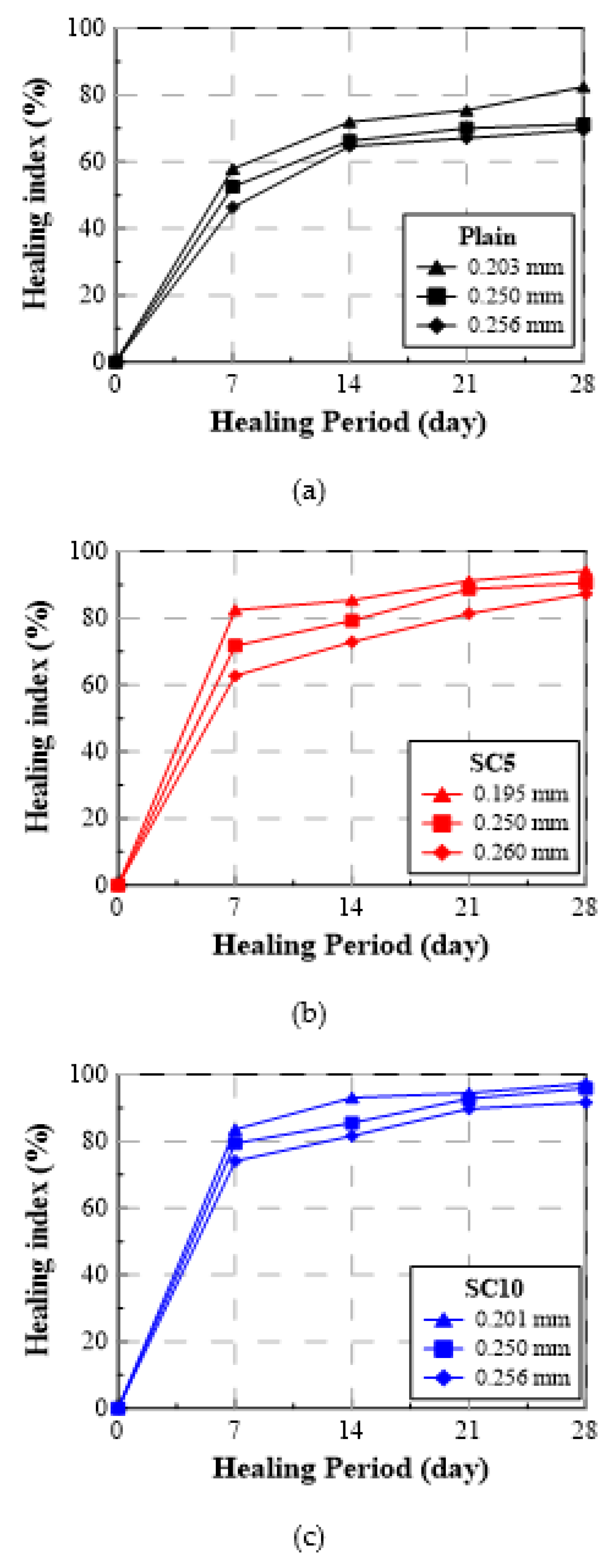
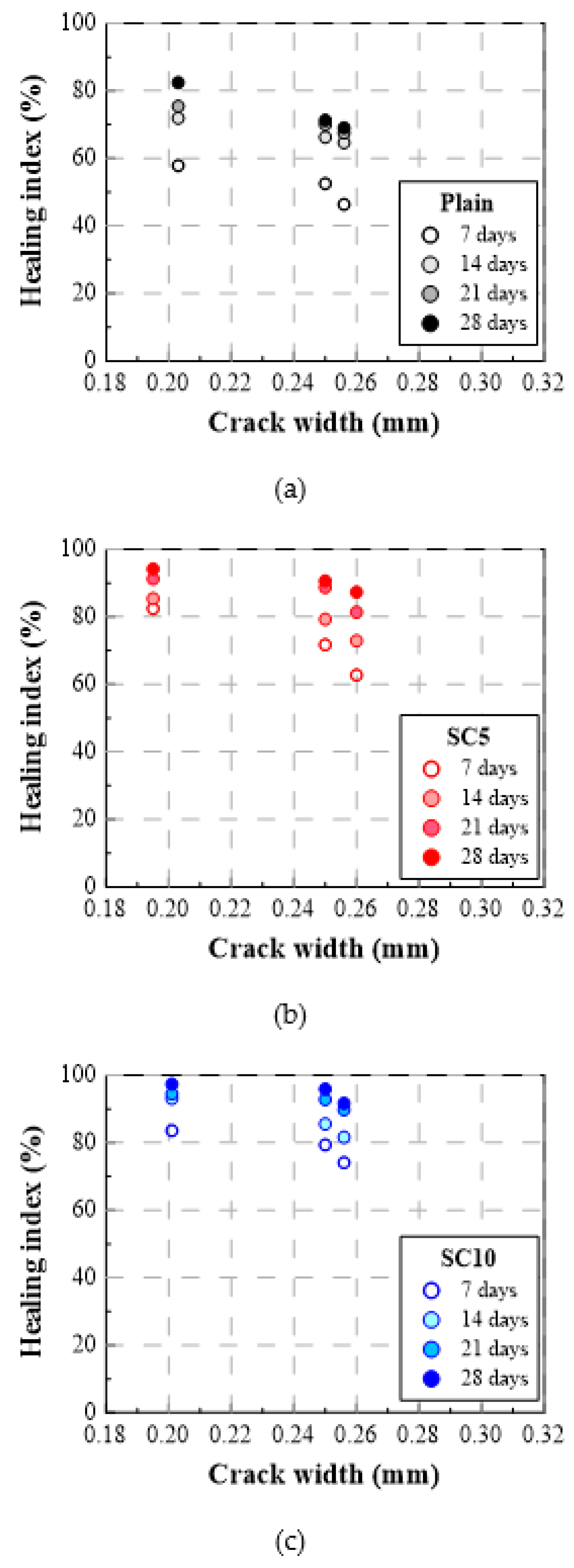

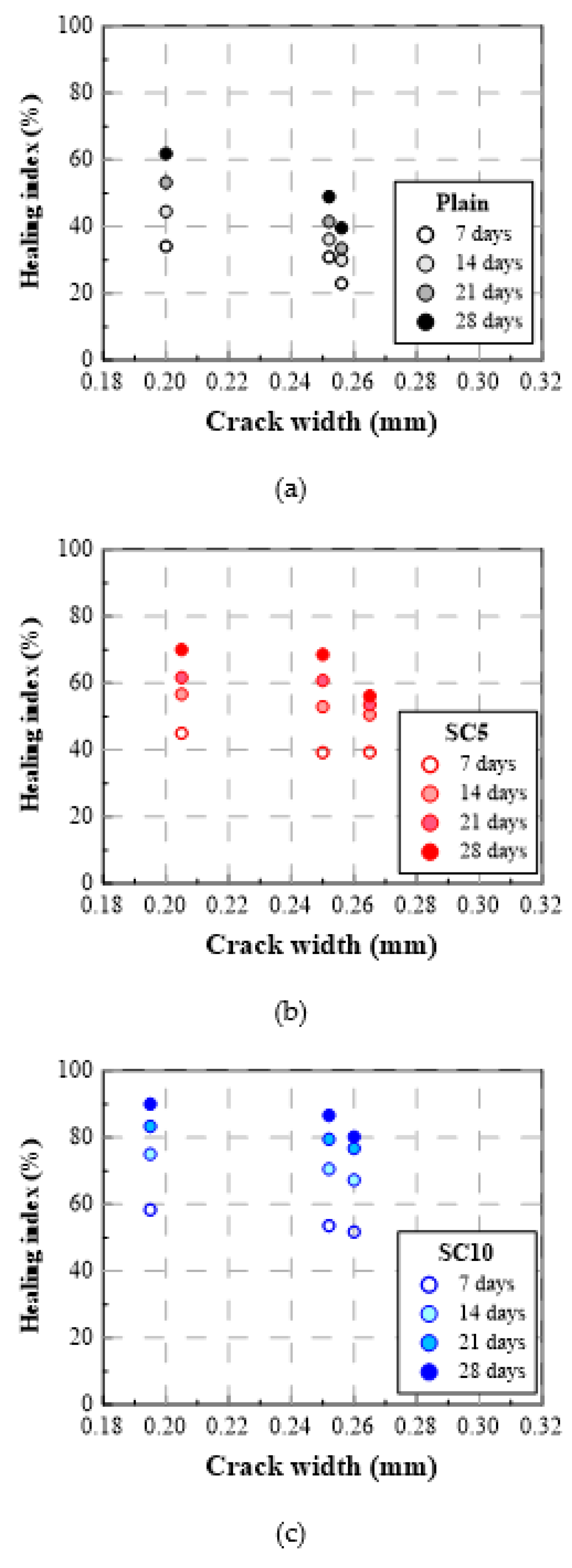

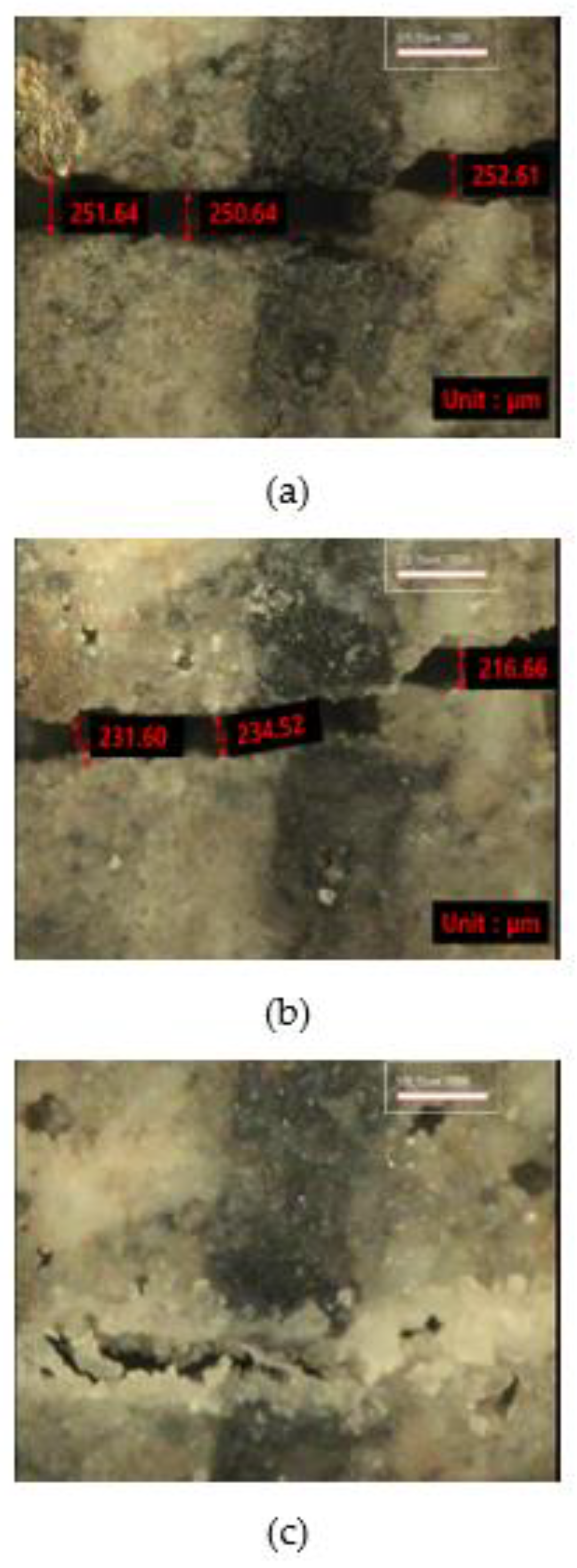

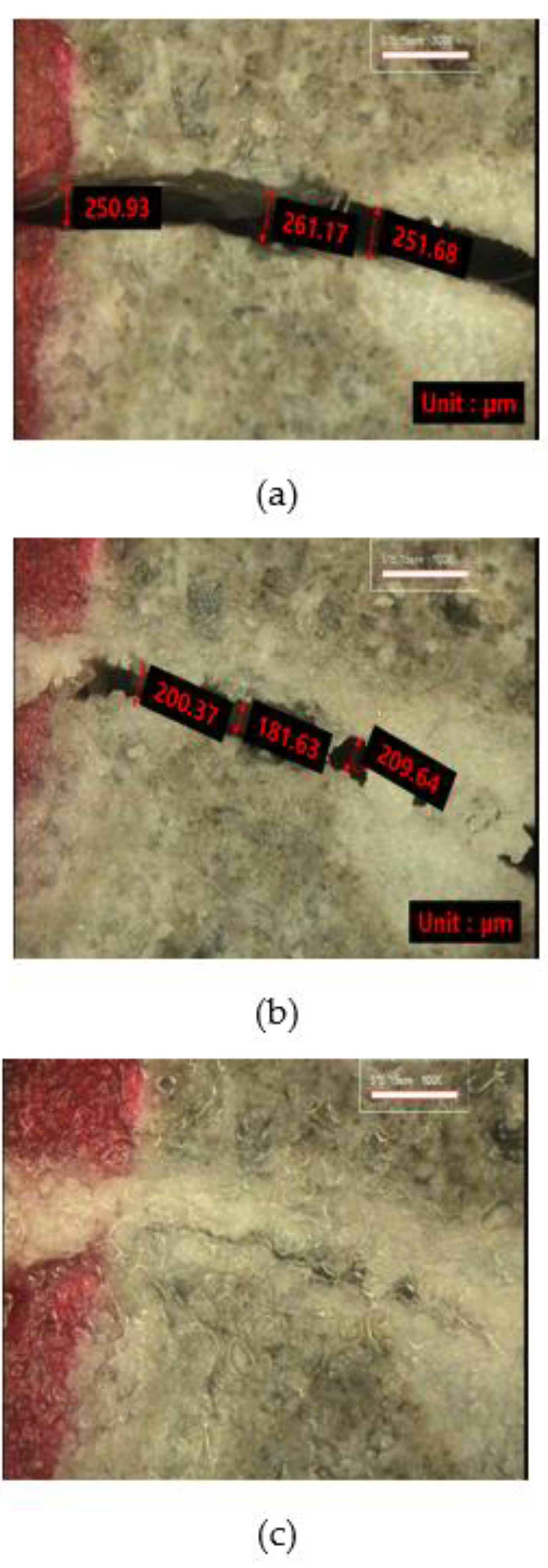
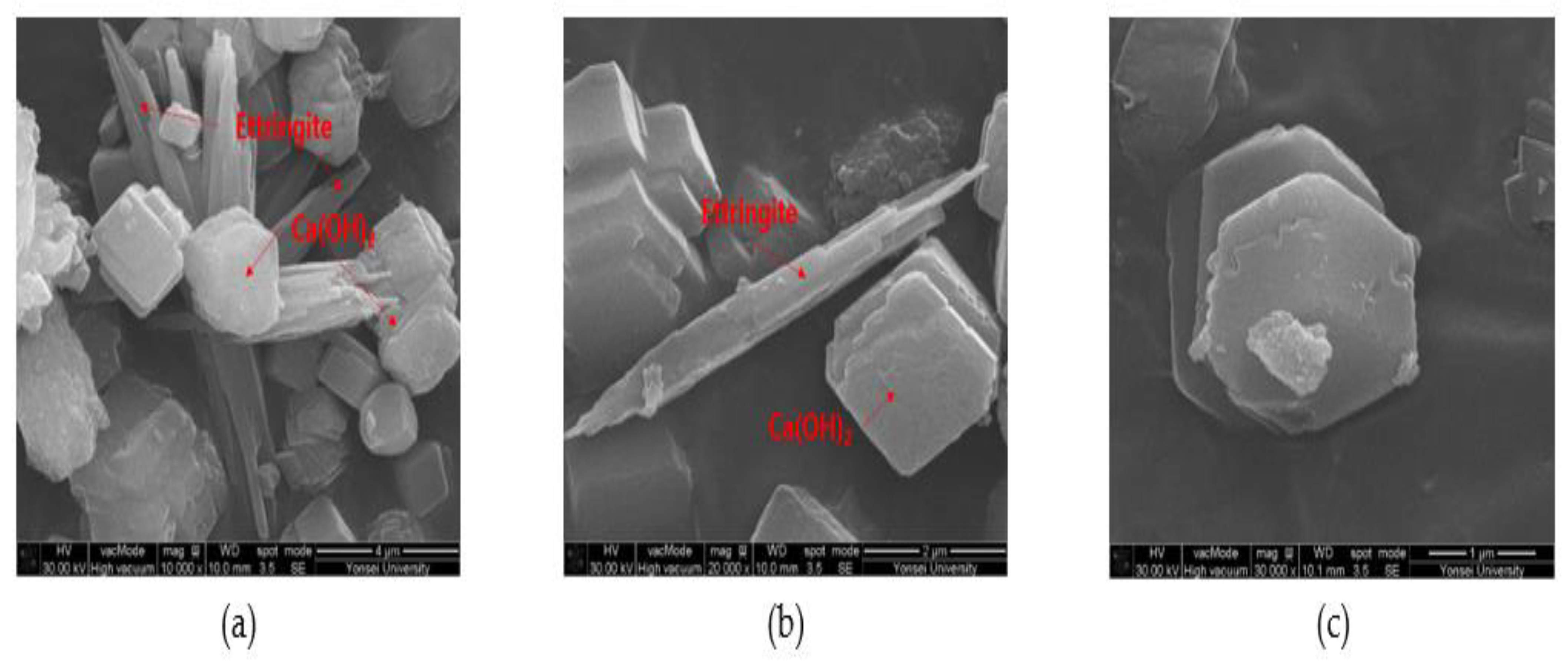
| Mix Type | Water | Binder | Fine Aggregate | PVA (Volume %) | SC | ||||
|---|---|---|---|---|---|---|---|---|---|
| 1.0 | 1.5 | ||||||||
| C | M | Z | #3 | #5 | #6 | ||||
| Plain | 0.4 | 0.88 | 0.06 | 0.06 | 0.40 | 0.70 | 0.40 | 0.1 | - |
| SC5 | 0.4 | 0.88 | 0.06 | 0.06 | 0.40 | 0.70 | 0.40 | 0.1 | 0.05 |
| SC10 | 0.4 | 0.88 | 0.06 | 0.06 | 0.40 | 0.70 | 0.40 | 0.1 | 0.10 |
| Mix Type | Plastic Viscosity (Pa·s) | Yield Stress (Pa) | Flow (mm) | Air Content (%) | ||
|---|---|---|---|---|---|---|
| 0 min | 30 min | 60 min | ||||
| Plain | 32.38 | 199.02 | 200 | 195 | 190 | 7.06 |
| SC5 | 28.37 | 153.71 | 195 | 190 | 187 | 7.01 |
| SC10 | 23.64 | 134.91 | 190 | 187 | 170 | 6.90 |
| Mix Type | Compressive Strength (MPa) | Bond Strength (MPa) | Flexural Strength (MPa) | Length Change (×10−6 με) | ||
|---|---|---|---|---|---|---|
| 3 Days | 7 Days | 28 Days | 28 Days | 28 Days | 28 Days | |
| Plain | 24.3 | 38.1 | 52.1 | 2.0 | 10.5 | −350 |
| SC5 | 22.2 | 36.0 | 49.4 | 1.8 | 10.3 | −310 |
| SC10 | 20.7 | 33.1 | 46.6 | 1.5 | 10.0 | −270 |
| Type | Crack Induction (Days) | Crack Width (mm) | Water Flow Rate (mL/(min × mm)) | Healing Index, SHq (Equation (2)) | |||||||
|---|---|---|---|---|---|---|---|---|---|---|---|
| 0d | 7d | 14d | 21d | 28d | 7d | 14d | 21d | 28d | |||
| Plain | 28 | 0.203 | 0.57 | 0.24 | 0.16 | 0.14 | 0.10 | 0.58 | 0.72 | 0.75 | 0.82 |
| 0.250 | 0.80 | 0.38 | 0.27 | 0.24 | 0.23 | 0.53 | 0.66 | 0.70 | 0.71 | ||
| 0.256 | 0.82 | 0.44 | 0.29 | 0.27 | 0.24 | 0.46 | 0.65 | 0.67 | 0.68 | ||
| 91 | 0.200 | 0.58 | 0.38 | 0.32 | 0.27 | 0.22 | 0.34 | 0.44 | 0.53 | 0.62 | |
| 0.252 | 0.94 | 0.65 | 0.55 | 0.47 | 0.39 | 0.31 | 0.36 | 0.41 | 0.49 | ||
| 0.265 | 1.14 | 0.88 | 0.80 | 0.76 | 0.69 | 0.23 | 0.30 | 0.33 | 0.40 | ||
| SC5 | 28 | 0.195 | 0.68 | 0.12 | 0.10 | 0.06 | 0.04 | 0.82 | 0.85 | 0.91 | 0.94 |
| 0.250 | 1.06 | 0.30 | 0.22 | 0.12 | 0.10 | 0.72 | 0.79 | 0.89 | 0.91 | ||
| 0.260 | 1.18 | 0.44 | 0.32 | 0.22 | 0.15 | 0.63 | 0.73 | 0.81 | 0.87 | ||
| 91 | 0.205 | 0.60 | 0.33 | 0.26 | 0.23 | 0.18 | 0.45 | 0.57 | 0.62 | 0.70 | |
| 0.250 | 1.02 | 0.62 | 0.48 | 0.40 | 0.32 | 0.39 | 0.53 | 0.61 | 0.69 | ||
| 0.265 | 1.14 | 0.69 | 0.56 | 0.53 | 0.50 | 0.39 | 0.50 | 0.54 | 0.56 | ||
| SC10 | 28 | 0.201 | 0.80 | 0.13 | 0.06 | 0.04 | 0.02 | 0.84 | 0.93 | 0.94 | 0.97 |
| 0.250 | 0.97 | 0.20 | 0.14 | 0.07 | 0.04 | 0.79 | 0.85 | 0.93 | 0.96 | ||
| 0.256 | 1.20 | 0.24 | 0.22 | 0.12 | 0.10 | 0.74 | 0.82 | 0.89 | 0.92 | ||
| 91 | 0.195 | 0.60 | 0.25 | 0.15 | 0.10 | 0.06 | 0.58 | 0.75 | 0.83 | 0.90 | |
| 0.252 | 1.12 | 0.52 | 0.33 | 0.23 | 0.15 | 0.54 | 0.71 | 0.79 | 0.86 | ||
| 0.260 | 1.16 | 0.56 | 0.38 | 0.27 | 0.23 | 0.52 | 0.67 | 0.76 | 0.80 | ||
Publisher’s Note: MDPI stays neutral with regard to jurisdictional claims in published maps and institutional affiliations. |
© 2022 by the authors. Licensee MDPI, Basel, Switzerland. This article is an open access article distributed under the terms and conditions of the Creative Commons Attribution (CC BY) license (https://creativecommons.org/licenses/by/4.0/).
Share and Cite
Oh, S.-R.; Lee, K.-M.; Choi, S.; Choi, Y.-W. Fundamental Properties and Self-Healing Performance of Repair Mortar with Solid Capsules Made Using Inorganic Reactive Powder. Materials 2022, 15, 1710. https://doi.org/10.3390/ma15051710
Oh S-R, Lee K-M, Choi S, Choi Y-W. Fundamental Properties and Self-Healing Performance of Repair Mortar with Solid Capsules Made Using Inorganic Reactive Powder. Materials. 2022; 15(5):1710. https://doi.org/10.3390/ma15051710
Chicago/Turabian StyleOh, Sung-Rok, Kwang-Myong Lee, Sung Choi, and Yun-Wang Choi. 2022. "Fundamental Properties and Self-Healing Performance of Repair Mortar with Solid Capsules Made Using Inorganic Reactive Powder" Materials 15, no. 5: 1710. https://doi.org/10.3390/ma15051710
APA StyleOh, S.-R., Lee, K.-M., Choi, S., & Choi, Y.-W. (2022). Fundamental Properties and Self-Healing Performance of Repair Mortar with Solid Capsules Made Using Inorganic Reactive Powder. Materials, 15(5), 1710. https://doi.org/10.3390/ma15051710






